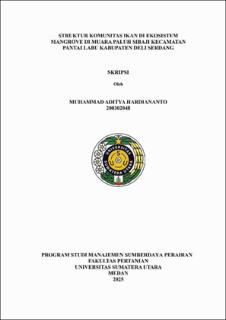Struktur Komunitas Ikan di Ekosistem Mangrove di Muara Paluh Sibaji Kecamatan Pantai Labu Kabupaten Deli Serdang
Fish Community Structure in the Mangrove Ecosystem at Muara Paluh Sibaji, Pantai Labu District, Deli Serdang Regency

Date
2025Author
Hardiananto, Muhammad Aditya
Advisor(s)
Susetya, Ipanna Enggar
Metadata
Show full item recordAbstract
Paluh Sibaji is a village in the subdistrict of Pantai Labu, Deli Serdang Regency, North Sumatra, and is directly bordered to the north by the Malacca Strait, which is covered with mangrove vegetation. Mangroves provide habitat, feeding grounds, and nurseries for various types of aquatic biota. This study aims to analyze the fish community structure in the mangrove ecosystem of Muara Paluh Sibaji, Pantai Labu subdistrict, Deli Serdang Regency. Data collection was carried out at three stations using four types of fishing gear (bubu, trawl nets, gill nets, and fishing rods). Physical and chemical parameters of the water, such as temperature, salinity, pH, brightness, and dissolved oxygen (DO), were measured to examine their relationship with fish diversity. The analysis was conducted on relative abundance, Shannon-Wiener diversity index (H'), evenness index (E), and dominance index (C), and the relationship between variables was tested using Principal Component Analysis (PCA). The results showed that 11 species were caught, with Eleutheronema tetradactylum (Senangin) being the most dominant with a relative abundance of 18.25% and Ambassis gymnocephalus (Ikan Pangkah) being the least dominant. The diversity index values ranged from 1.95 to 2.29, indicating that the community was in a moderate and stable condition because it had a fairly diverse fish community without any species that completely dominated. The salinity and brightness parameters had a positive correlation with diversity, while pH showed a negative correlation.
Collections
- Undergraduate Theses [817]
